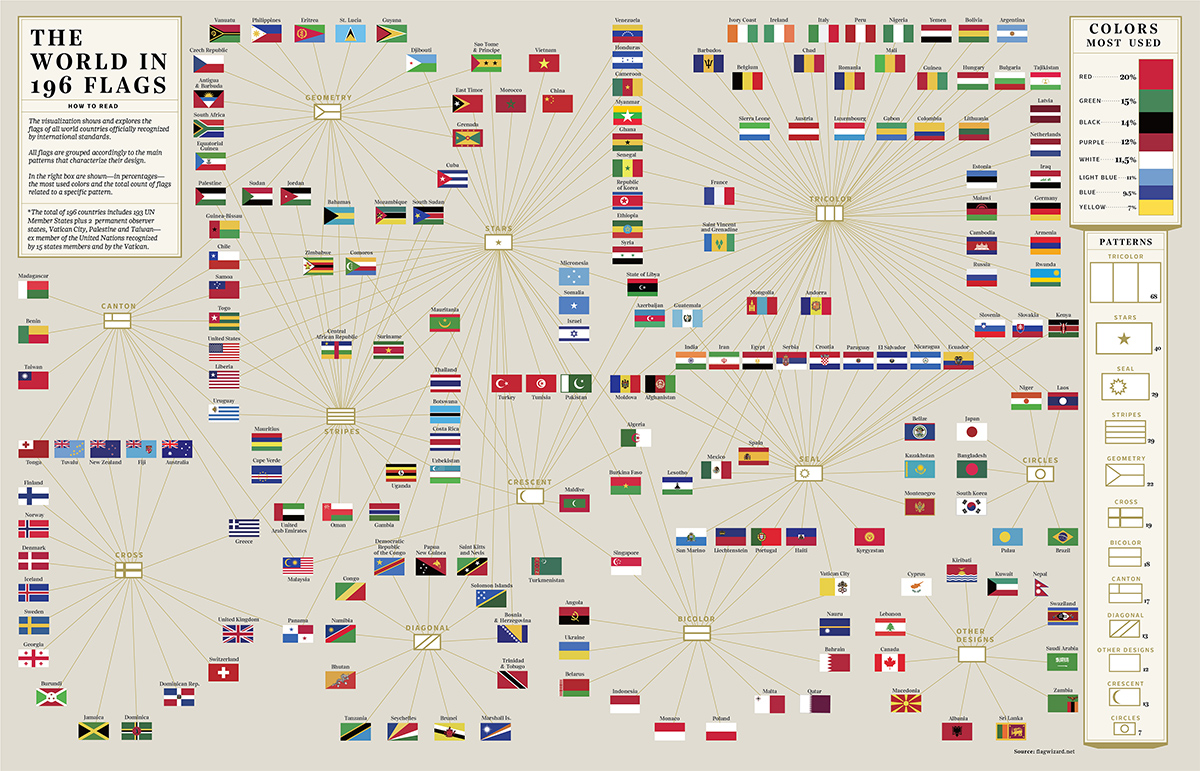Historically, flags primarily served as a means of identification in warfare, but today, national flags are flown to represent a country both on the international stage and domestically.
Every flag incorporates design elements and colors that symbolize certain aspects of each country’s history and identity. And as you’ve likely noticed, many of them fall under similar color conventions or patterns, except for a few rare outliers.
This visualization by Giulia De Amicis shows flags of 196 countries recognized by international standards, grouped according to the key design characteristics—color and pattern.
It includes 193 United Nations Member States, two permanent non-member observer states—Vatican City and Palestine, and Taiwan, a self-ruled democracy and an ex-member of the UN.
Flags of Countries: Common Shapes and Aspect Ratio
Most countries have flags in a quadrilateral shape—a four-sided polygon with four edges and four corners—mainly with a 2:3 or 1:2 aspect ratio.
In contrast, the flag of Nepal stands out with its unique layout. It consists of two triangular shapes with a white moon on the top and a white sun on the bottom section.

The unusual flag’s design has at times caused difficulties for large-scale reproduction.
In the 2016 Summer Olympics, for example, the Nepalese flag was placed on a white rectangular cloth shaped the same as other flags.
What are the most popular colors in flags?
By far, the most popular color used in national flags is red, with 20% of listed countries featuring it in their flag design. In vexillology—the study of flags—it is believed that red is a symbol of power, bravery, revolution, and vibrancy, as well as war regarding past bloodshed.
Green comes as the second most used flag color with 15% of countries incorporating it, followed by black (14%), purple (12%), white (11.5%), light blue (11%), and blue (9.5%). Yellow was the least popular with just 7% of countries using it in their national flags.
Certain regions share a distinct mix of colors that neighboring countries have adopted. For example, red, white, green, and black are seen in several Arab nation flags. Similarly, green, red, and yellow combinations are often symbolic of Pan-African countries.
Patterns and symbolism behind flag design
A simple tricolor design, in either a vertical and horizontal orientation, is the most frequent pattern, with 68 countries displaying it on their flags. Stars follow with 40 country flags, while 29 flags had either a seal or stripes.
Related story: Mapped: All the world’s military personnel
But there are many other flag designs to consider, such as the geometrical designs used by Cuba and South Africa, crosses like the Union Jack of the UK, and circles like those of Japan and South Korea. And not every flag fits one design category, such as Pakistan’s white and green flag with a crescent and star, or the many flags that include a Union Jack within their design.
Symbolism ascribed to flag design can range from abstract to more literal explanations. The meaning of flag designs can change over time, too, often influenced by major political shifts.
For example, the red flag of the People’s Republic of China has one prominent yellow star, which used to stand for the Chinese Communist Party, while the smaller stars were previously associated with the four social classes making up the society. Today, the large star represents China itself, while the smaller stars stand for the country’s many national minorities.
In a similar manner, other nations have changed their flag designs to reflect major political changes, or people have ascribed their own revised meanings to the elements depicted in their country’s flag.
Which nation’s flag catches your eye? Are there any other flags that are memorable or unique but not featured on this list?
Story attributed of Visual Capitalist.

